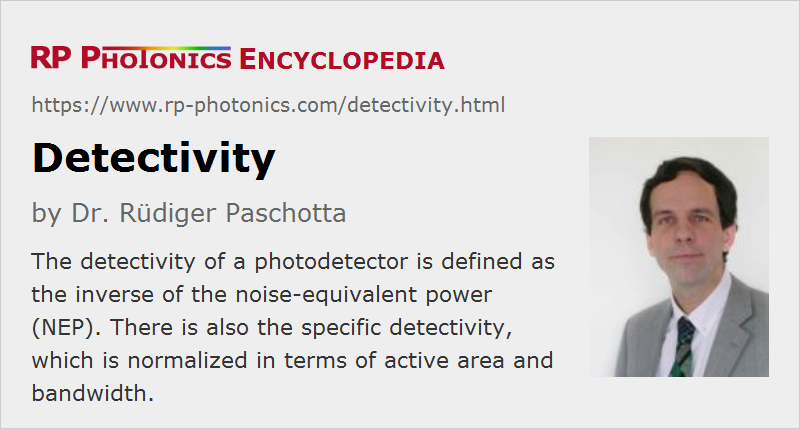Detectivity
Definition: the inverse of the noise equivalent power
German: Detektivität
Categories: light detection and characterization, fluctuations and noise
Formula symbol: D
Units: 1 / W; cm Hz1/2 / W (specific detectivity)
How to cite the article; suggest additional literature
Author: Dr. Rüdiger Paschotta
The detectivity D of a photodetector is a figure of merit, defined as the inverse of the noise-equivalent power (NEP). The larger the detectivity of a photodetector, the more it is suitable for detecting week signals which compete with the detector noise.
The specific detectivity D* is the detectivity normalized to a unit detector area and detection bandwidth; one can calculate it by multiplying the detectivity with the square root of the product of detector area (in square centimeters) and the detector bandwidth (in Hz). That term is useful for comparing the performance of different detector technologies. If the detector bandwidth scales inversely with the active area, e.g. because of the limiting impact of the electrical capacitance, the specific detectivity will be independent of the active area.
For a given detector, one may decrease the noise level, thus reducing the noise-equivalent power and increasing the detectivity, by restricting its detection bandwidth (e.g. by adding a low-pass filter). Assuming white noise, one will then obtain the same specific detectivity as before.
Questions and Comments from Users
Here you can submit questions and comments. As far as they get accepted by the author, they will appear above this paragraph together with the author’s answer. The author will decide on acceptance based on certain criteria. Essentially, the issue must be of sufficiently broad interest.
Please do not enter personal data here; we would otherwise delete it soon. (See also our privacy declaration.) If you wish to receive personal feedback or consultancy from the author, please contact him e.g. via e-mail.
By submitting the information, you give your consent to the potential publication of your inputs on our website according to our rules. (If you later retract your consent, we will delete those inputs.) As your inputs are first reviewed by the author, they may be published with some delay.
See also: noise-equivalent power, photodetectors
and other articles in the categories light detection and characterization, fluctuations and noise
 |




If you like this page, please share the link with your friends and colleagues, e.g. via social media:
These sharing buttons are implemented in a privacy-friendly way!